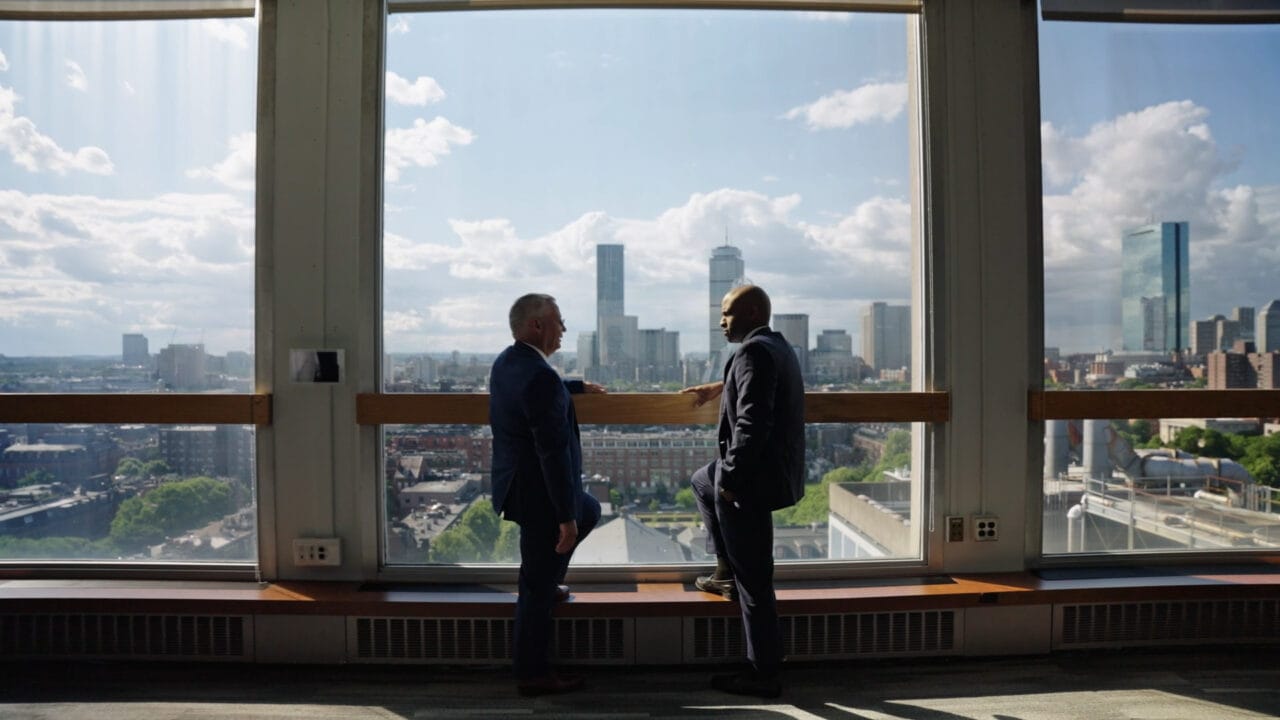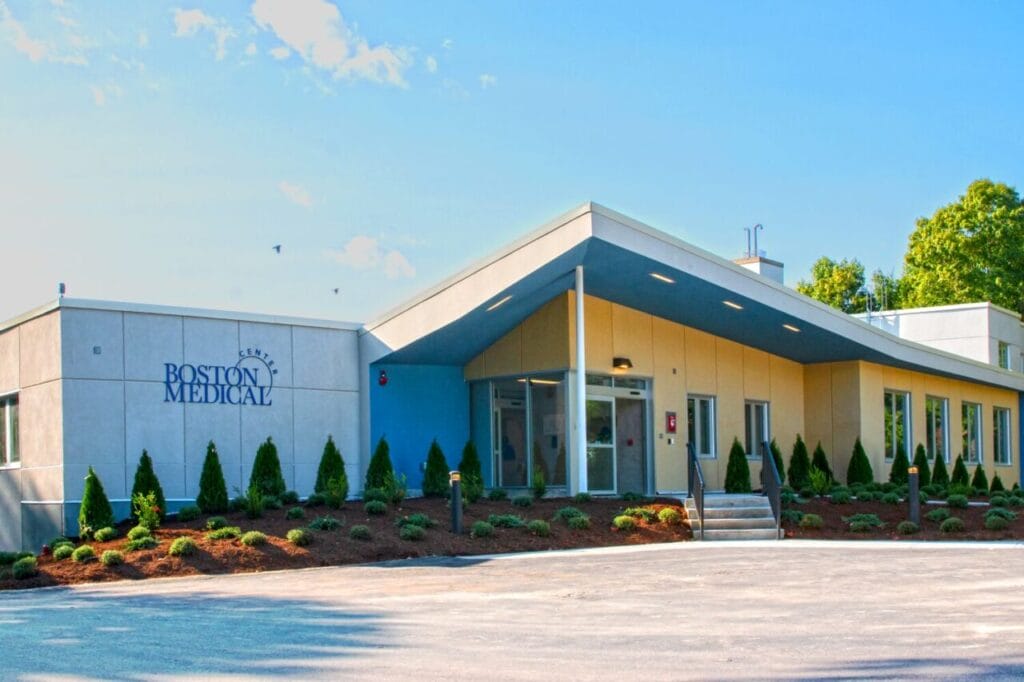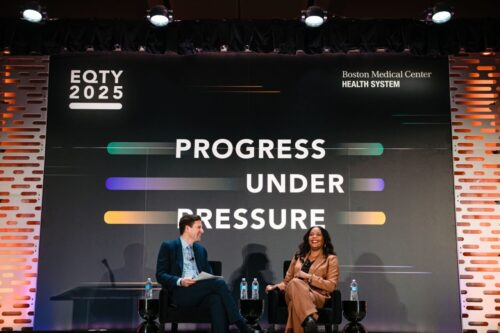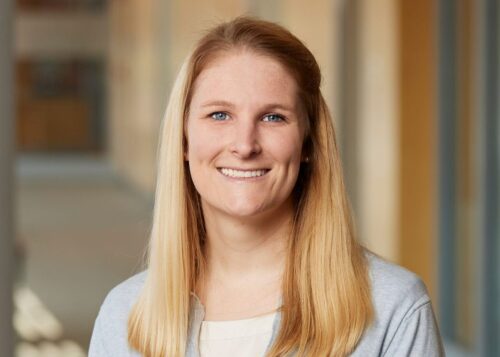How Oakwell, Founded by BMCHS and Omicelo, Is Revolutionizing Sustainability in Healthcare
August 15, 2024

Boston Medical Center
Smartly investing in sustainability not only has proven return on investment, it has what Omicelo founder Joshua Pollard calls an "impact on investment," creating a healthier environment for patients and the community.
Joshua Pollard is open about experiencing homelessness the first two years of his life in Pittsburgh. His mother tells him stories he says are almost unbelievable, of using the same diaper for a week. After then growing up in Section 8 housing, everything changed when he had the opportunity to enroll in a private high school, with help from a wealthy local family. Pollard calls it his earliest introduction to vast, material differences in wealth. With that opportunity, Pollard skyrocketed through academia and corporate careers: degrees in economics and statistics from the University of Rochester and a lightning rod career at Goldman Sachs. It was along that road that he had what he calls "a suite of come-to-Jesus moments."
"I had learned how to make money pretty well, and I really wanted to make a difference, too," he says.
So, he moved back home to Pittsburgh and he started Omicelo, a private equity investment group focused on advancing access to healthcare, housing, economic growth, and a healthy environment. It's that commitment to mission that brought Omicelo face to face with Boston Medical Center (BMC), a national leader in health equity.
Now, Omicelo and BMC Health System have partnered to launch Oakwell, a sustainability management and real estate optimization firm. Oakwell partners with health systems to develop custom energy efficiency and reduced consumption programs that reduce system cost and can support reinvestment in patient care. BMC’s Chief Sustainability & Real Estate Officer Robert (Bob) Biggio’s campus redesign project and BMC's own work in sustainability serves as the proof of concept for this work.
HealthCity spoke with both Biggio and Pollard about their partnership, Oakwell, and the importance of both a return on investment and a return on impact.
HealthCity: Both Omicelo and BMC are mission focused. Can you speak more to that idea of mission and how you relate to it?
Joshua Pollard: Omicelo is focused on SustainAbility—with a capital "A." That is the genuine ability of humanity to have access to quality healthcare, viable housing, economic growth opportunities, and a thriving environment. I could not be more passionate about the idea of making an attractive return on investment and impact on investment at the same time.
Return on investment is clear, but impact on investment is asking, how much impact do you get out based on your investments? How many more people have access to healthcare? How many more people are engaging their lives in a healthier environment?

Bob Biggio: I'm marine engineer by background. I fell into healthcare sitting at the board table when I was 27. Up until the time I got to BMC, one of the themes I heard over and over again around the board table is we need to grow our patient volumes in order to be financially sustainable. I never heard that here at BMC.
Instead, what I always heard was BMC was constantly looking at how to go upstream and prevent people from needing to come to the hospital. It's really why I thought BMC was the right place to do proof of concept for our nation’s healthcare reform journey. Because, ultimately, if a healthcare organization is just focused on growing volume, you, in a way, tie your ability to succeed to needing an increasingly sick community. It's the exact opposite of what our healthcare system should be doing.
HC: How did the partnership for Oakwell come about?
JP: One day, I was out with my kids, listening to a radio station, and the host was talking about BMC investing $6 million into an affordable housing fund, and I was very intrigued.
The folks at BMC had invited Omicelo to Boston for a symposium, and there's where I met the great Dr. Thea James. When you say, “we hit it off,” that’s an understatement. She introduced me to Bob Biggio, and we had an unforgettable first meeting. We talked about everything from Christianity, to affordable housing, to best-in-class construction, to music, and food.
From that point, once a quarter, I made it a point to fly to Boston to meet. Bob’s assistant would clear a half a day on his calendar, and we would spend time together. We always said, “At some point, we're going to find something amazing to work on.” And that amazing thing turned out to be Oakwell.

BB: During the pandemic, Joshua and I were meeting in my office, and out of the blue he said to me, "Bob, the more I've learned about the work you've done here at BMC, you have to help other organizations. It's something that our healthcare system needs more broadly. How can we partner together to export this work?" And that's kind of the way Oakwell came to be.
I've loved working for a nonprofit because I may never be able to donate a million dollars, but I can save it. What you're doing is genuinely giving back to your community and helping the people we serve.
With Joshua's upbringing, his goal in his investing helping communities participate in the improvement of their environment and the financial improvements of their communities. His interests were very much aligned.
HC: BMC provides the proof of concept for Oakwell. How does BMC think differently about the intersection between healthcare, sustainability, and real estate?
BB: The biggest thing BMC has done differently is look at sustainability holistically. It's not one project; it has been integrated into our overall organizational and real estate strategy. That's not by accident. If you're going to fulfill the promise of healthcare reform, you have to proactively look to keep your community healthy. For me, the environment, the air we breathe, the water we drink, is foundational to that. At the start, I made environmental sustainability essentially one of the cornerstones of the campus redesign plan.
The other thing we've done differently is take our fiduciary responsibilities very seriously. I've worked really hard to try to make sure when we've made these investments, they've been done in a way that will improve our ability to care for our patients and increase the resources available to our clinicians. I never expected it would have as positive an impact as it has had, but I think the way we've done it has produced much greater benefits than we ever anticipated when we started. Now we are able to predict some of these improvements with BMC as the proof of concept.
JP: The underlying, now-false narrative is that to do things sustainably means to do them more expensively. That false narrative is actively being debunked. Many local, state, and now federal governments all over the world have created subsidies and incentives, and it's made a real difference in the ability to have sustainability contribute to both return on investment and impact on investment in the healthcare sector.
What's always been cool to me is that Boston Medical Center has been able to prove that out already, before many of the big recent financial incentives emerged. Boston Medical Center is best-in-class. So, the way I thought about it was: how can we export this experience to the rest of the healthcare sector and could the impact of appropriately exporting it result in more people having SustainAbility with a capital "A"? That's always been the channel through which we've talked about this partnership between BMC and Omicelo that created Oakwell.
HC: Can you think of a specific example of how those cost savings and costs averted from sustainability has allowed BMC to reinvest back into patient care?
BB: The project I am most proud of in my career is our Brockton Behavioral Health Center. It's actually not because it's a net-zero facility, it's more because of how we were able to bring behavioral health care to our patients.
Our organization had been talking for many, many years about how our patients need inpatient psychiatry beds. We had patients that were in our emergency room for weeks waiting for beds that were unavailable around the city and state.
When I found that site down in Brockton, I knew that all the financial savings that we had generated over the previous eight years from our sustainability, energy efficiency, and real estate work had put us in a position that we could afford to try to do that for our patients. Even though it's very hard to make an inpatient psychiatry facility with Medicaid population work financially, we were able to try to do it.

Now we have 82 beds where patients are getting the care that they need where historically they weren't getting that care. For me, that's kind of exactly why we were doing this work: to create that new access to help people that really needed the help but were unable to get it historically.
HC: How does Oakwell work, logistically, to help other health systems get similar financial returns on investment?
JP: We could have said, "Okay, Bob, leave Boston Medical Center and go to some other health system and do it again over the next 10 years." That's great for that system, but we had to figure out a business model to be able to help hundreds, if not thousands, of hospitals at the same time if we really wanted to make impact.
It starts with a dual approach. First and foremost, we place a team member inside their system. We fit within their culture while we support them in maturing and building deeper understanding of their sustainability program. That's where you gather the learnings, the idiosyncrasies, and individual nature not just of a health system, but of individual hospitals within a health system, individual buildings within a hospital.
The biggest thing BMC does differently is we've looked sustainability holistically. It's not one project; it has been integrated into our overall organizational and real estate strategy from its inception.
Bob Biggio, bmc's chief sustainability & real estate officer
That's how you gain understanding of how you get return on investment and impact on investment.
Second, while there's a person who's embedded in your hospital and health system with deep specificity, they're also being guided by bonafide best-in-class experts in real estate, sustainability, engineering, and finance. We call this our Core Hub supports. It's the combination of the individual touch and the central expertise that allows there to be this non-one-size-fits-all to occur. We seek individual success at multiple systems at once. That’s the scale that our communities need.
HC: You've both been clear that Oakwell is not a consultancy. Can you explain how this work is different?
BB: I felt really strongly about having a business model where we embed a person in an organization and become part of the organization and partner with them.
JP: We have no desire to be a consultant. We are looking to build long-term partnerships and participate alongside these health systems over a long term — that's what we want to be known for.

BB: I've been doing this for almost 30 years, and I've seen over and over again where consultants come in, they give you a couple of what they believe to be great ideas, and they leave. In my experience, those ideas are often good for a short time, or if you look at them in the context of everything the organization is trying to achieve strategically, they may not actually fit.
Embedding someone allows you to get that to a level of detail that you can create a plan that is much more comprehensive, much more forward-looking, and is in the context of what an organization is trying to achieve strategically for their mission. To me, that's what's important, and that tends to produce much better returns and impact.
HC: What are your future goals with Oakwell?
BB: With Oakwell, we have a goal of, over the next 10 years, saving the health systems we work for enough money that they will be able to provide access to care to one million more people—and that would require about $15 billion in savings. That's why I started doing this work, and it's why we're going to continue to help others. We're going to make the organizations we work for more financially sustainable as well as environmentally sustainable.
JP: Helping customers achieve their goals, that's step one, two, and three. What we've learned is that many hospital executives would love to say they're the greenest and most profitable hospital in their region, city, or state— they just need comprehensive support and execution capability to do so. We can provide that comprehensive support and execution capability. That's what we'll be doing until the job is done, and I'm expecting us to do it incredibly well.
*This interview has been edited and condensed for clarity and length.


